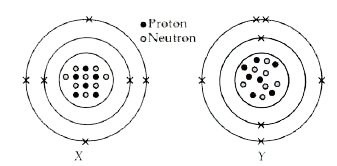X, Y and Z are three consecutive elements. X on addition of one electron and Y on addition of two electrons become isoelectronic with element Z.
Select correct statement:
Difference between atomic number of X and Y is 3.
Difference between total number of protons of X and Y is 2.
Both (A) and (B).
Difference between atomic number of X and Z is 1.
The correct Answer is:D
Step by step video, text & image solution for X, Y and Z are three consecutive elements. X on addition of one electron and Y on addition of two electrons become isoelectronic with element Z. Select correct statement: by Chemistry experts to help you in doubts & scoring excellent marks in Class 12 exams.
Similar Questions
The given diagrams show the atomic structures of elements X and Y.

What are the electronic configurations of elements X and Y?View SolutionBased on the information given in the below three statements, answer the following questions.
(i) Element X has two valence electrons in the M-shell.
(ii) In element Y, the electrons are distributed in the first three shells. It has eight electrons in the M-shell.
(iii) Element Z has eight electrons in the penultimate shell, i.e., M.
(a) Give the electronic configuration of X.
(b) Which element is stable among X, Y and Z and why?
(c) In which atom of an element is the number of electrons distributed in all the four shells?
(d) What is the atomic number of Z in which the number of electrons in the first and the last shell are not the same?
(e) What are the number of electrons and protons present in Y?View Solution
Knowledge Check
- Question 1 - Select One
X, Y and Z are three consecutive elements. X on addition of one electron and Y on addition of two electrons become isoelectronic with element Z.
Element Y will have following property:AAtomic number of Y is higher than atomic number of Z.BAtomic number of Y is higher than atomic number of X.CElement Y is placed in periodic table at left side of element X if both are in same period.DNone of these - Question 2 - Select One
X, Y and Z are three consecutive elements. X on addition of one electron and Y on addition of two electrons become isoelectronic with element Z.
Element Y will have following property:AAtomic number of Y is higher than atomic number of Z.BAtomic number of Y is higher than atomic number of X.CElement Y is placed in periodic table at left side of element X if both are in same period.DNone of these - Question 3 - Select One
X, Y and Z are three consecutive elements. X on addition of one electron and Y on addition of two electrons become isoelectronic with element Z.
Element Y will have following property:AAtomic number of Y is higher than atomic number of Z.BAtomic number of Y is higher than atomic number of X.CElement Y is placed in periodic table at left side of element X if both are in same period.DNone of these
The electronic configuration of an elements 'E' (Z = 16) is 2, 8, 6. Will it lose six electrons or gain two electrons easily ?
View SolutionMany transition elements also form 3+ ions by losing one (n−1)d electron in addition to the two ns electrons except
View SolutionConsider the following statements
Transition elements have high melting points
Greater number of electrons are involved from (n-l) d in addition to ns electrons in the interatomic metallic bonding.
Select the correct option.View SolutionTwo elements X and Y contain only one electron in the outer level.Element X is reactive and loses electron easily while element Y is relatively unreactive and non-corrosive.The elements X and Y respectively are
View SolutionIf x,y and z are electronegativity, ionisation potential and electron−affinity respectively. Then the electron affinity (z) in the terms of electronegativity (x) and ionisation potential (y) will be :
View Solution

